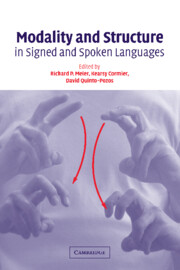Book contents
- Frontmatter
- Contents
- List of figures
- List of tables
- List of contributors
- Acknowledgements
- 1 Why different, why the same? Explaining effects and non-effects of modality upon linguistic structure in sign and speech
- Part I Phonological structure in signed languages
- 2 Modality differences in sign language phonology and morphophonemics
- 3 Beads on a string? Representations of repetition in spoken and signed languages
- 4 Psycholinguistic investigations of phonological structure in ASL
- 5 Modality-dependent aspects of sign language production: Evidence from slips of the hands and their repairs in German Sign Language
- 6 The role of Manually Coded English in language development of deaf children
- Part II Gesture and iconicity in sign and speech
- Part III Syntax in sign: Few or no effects of modality
- Part IV Using space and describing space: Pronouns, classifiers, and verb agreement
- Index
- References
2 - Modality differences in sign language phonology and morphophonemics
Published online by Cambridge University Press: 22 September 2009
- Frontmatter
- Contents
- List of figures
- List of tables
- List of contributors
- Acknowledgements
- 1 Why different, why the same? Explaining effects and non-effects of modality upon linguistic structure in sign and speech
- Part I Phonological structure in signed languages
- 2 Modality differences in sign language phonology and morphophonemics
- 3 Beads on a string? Representations of repetition in spoken and signed languages
- 4 Psycholinguistic investigations of phonological structure in ASL
- 5 Modality-dependent aspects of sign language production: Evidence from slips of the hands and their repairs in German Sign Language
- 6 The role of Manually Coded English in language development of deaf children
- Part II Gesture and iconicity in sign and speech
- Part III Syntax in sign: Few or no effects of modality
- Part IV Using space and describing space: Pronouns, classifiers, and verb agreement
- Index
- References
Summary
Introduction
In this chapter it is taken as given that phonology is the level of grammatical analysis where primitive structural units without meaning are combined to create an infinite number of meaningful utterances. It is the level of grammar that has a direct link with the articulatory and perceptual phonetic systems, either visual–gestural or auditory–vocal. There has been work on sign language phonology for about 40 years now, and at the beginning of just about every piece on the topic there is some statement like the following:
The goal is, then, to propose a model of ASL [American Sign Language] grammar at a level that is clearly constrained by both the physiology and by the grammatical rules. To the extent that this enterprise is successful, it will enable us to closely compare the structures of spoken and signed languages and begin to address the broader questions of language universals …
(Sandler 1989: vi)The goal of this chapter is to articulate some of the differences between the phonology of signed and spoken languages that have been brought to light in the last 40 years and to illuminate the role that the physiological bases have in defining abstract units, such as the segment, syllable, and word. There are some who hold a view that sign languages are just like spoken languages except for the substance of the features (Perlmutter 1992).
Information
- Type
- Chapter
- Information
- Modality and Structure in Signed and Spoken Languages , pp. 35 - 64Publisher: Cambridge University PressPrint publication year: 2002
References
Accessibility standard: Unknown
Why this information is here
This section outlines the accessibility features of this content - including support for screen readers, full keyboard navigation and high-contrast display options. This may not be relevant for you.Accessibility Information
- 25
- Cited by
